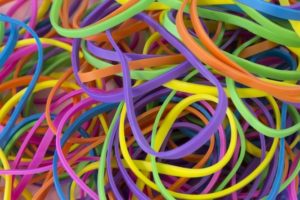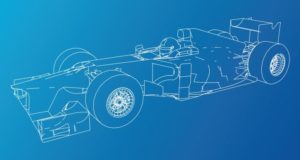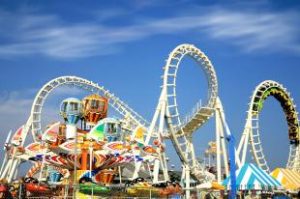This lesson explores the design of rubber band powered cars. Students work in teams of “engineers” to design and build their own rubber band cars out of everyday items. They test their rubber band cars, evaluate their results, and present to the class.
- Design and construct a rubber band car
- Measure distance and calculate velocity
- Test and refine designs
Age Levels: 8 – 18
Lesson Plan Presentation
Materials & Preparation
Build Materials (For each team)
Required Materials

Dana Zurkiyeh-bigstock.com
- 16 in. x 16 in. piece of corrugated cardboard (or a cereal box/smaller piece of cardboard)
- 4 Rubber Bands
Alternative Materials
- Paperclips
- Plastic bottle, yogurt or takeout lids
- CD’s or DVD’s
- Paper/styrofoam plates
- Unsharpened pencils
- Thumbtacks
Testing Materials
- Masking tape or other colored tape
- Measuring tape/stick
- Stopwatch
Testing Materials & Process
Materials
- Masking tape or other colored tape
- Measuring tape/stick
- Stopwatch
Process
- Use masking tape to create a 3ft wide by at least 10ft long track on the floor. Allow the teams to launch the cars, which must travel in a straight line for a distance of at least 10 feet.
- Measure the distance and calculate the speed.
- Each team calculates their car’s velocity.
- Distance traveled divided by the time it took to travel that distance in a forward direction within the track.
Real World Applications
Have you ever seen an adult-sized rubber band car? (Video, 0:34)
At the 2007 Maker Faire™ in Austin, TX, Brian Watt demonstrated his experimental, adult-sized, rubber band car. His design used 80+ layers of cardboard, about 1 1/2 gallons of glue, and six 84-inch x 1-inch rubber bands. He based his design on the Amazing Rubber Band Cars book by Mike Rigsby.
Source: YouTube
Learn about Sir Isaac Newton’s laws of force and motion at the amusement park. (Video 3:02)
Source: YouTube – Idaho Public Television Channel, PBS Science Trek
Velocity refers to how fast an object is moving in a particular direction. Speed refers to how fast an object is moving. (Video 8:23)
Source: PBS Physics in Motion
The push or pull of an object is force. Friction is the force that holds back the movement of an object. (Video 2:08)
Source: YouTube – Smithsonian Science Education Center
Engineering Design Challenge
Design Challenge
You’re a team of engineers given the challenge of designing a rubber band car out of everyday items. The car must be able to travel in a straight line within a track for a distance of at least 10 feet (3 meters) within a 3 foot (1 meter) wide track.
Criteria
- Must be able to travel in a straight line within a track for a distance of at least 10 feet (3 meters) within a 3 foot (1 meter) wide track.
- The car that can travel within the track for the greatest distance is the winner.
Constraints
- Can only use the materials provided.
- Teams may trade materials to develop their ideal parts list.
Activity Instructions & Procedures
Procedure
- Break class into teams of 2-4.
- Hand out the Design a Rubber Band Racer worksheet, as well as some sheets of paper for sketching designs.
- Discuss the topics in the Background Concepts Section.
- Review the Engineering Design Process, Design Challenge, Criteria, Constraints and Materials. If time allows, review “Real World Applications” prior to conducting the design challenge.
- Before instructing students to start brainstorming and sketching their designs, ask them to consider the following:
• How does a rubber band work?
• What might make one car go faster than another?
• Does friction impact the design in addition to force?
• How does weight impact the design? - Provide each team with their materials.
- Explain that students must develop a car powered by rubber bands from everyday items, and that the rubber band car must be able to travel in a straight line for a distance of at least 3 meters within a 1 meter wide track. Rubber bands cannot be used to slingshot the cars. The car that can travel in a straight line for the greatest distance is the winner.
- Announce the amount of time they have to design and build (1 hour recommended).
- Use a timer or an on-line stopwatch (count down feature) to ensure you keep on time. (www.online-stopwatch.com/full-screen-stopwatch). Give students regular “time checks” so they stay on task. If they are struggling, ask questions that will lead them to a solution quicker.
- Students meet and develop a plan for their rubber band car. They agree on materials they will need, write/draw their plan, and present their plan to the class. Teams may trade unlimited materials with other teams to develop their ideal parts list.
- Teams build their designs.
- Test the car designs using a track that is set up ahead of time (see Testing Materials/Process). Record the distance traveled and speed for each design.
- Teams should document the distance their car traveled and the speed.
- Each team then calculates their car’s velocity
• Distance traveled divided by the time it took to travel that distance in a forward direction within the track. - As a class, discuss the student reflection questions.
- For more content on the topic, see the “Digging Deeper” and “Real World Applications” sections.
Student Reflection (engineering notebook)
- Did you succeed in creating a rubber band car that traveled in a straight line for 3 meters within the track? If so, how far did it travel? If not, why did it fail?
- Did you negotiate any material trades with other teams? How did that process work for you?
- What is the average speed your car achieved?
- Did you decide to revise your original design or request additional materials while in the construction phase? Why?
- If you could have had access to materials that were different than those provided, what would your team have requested? Why?
- Do you think that engineers have to adapt their original plans during the construction of systems or products? Why might they?
- If you had to do it all over again, how would your planned design change? Why?
- What designs or methods did you see other teams try that you thought worked well?
- Do you think you would have been able to complete this project easier if you were working alone? Explain…
Time Modification
The lesson can be done in as little as 1 class period for older students. However, to help students from feeling rushed and to ensure student success (especially for younger students), split the lesson into two periods giving students more time to brainstorm, test ideas and finalize their design. Conduct the testing and debrief in the next class period.
Engineering Design Process
Background Concepts
Automotive Engineering

Mirexon-bigstock.com
Automotive engineers design the vehicles that we use for life, work, and play. They are involved in aspects of engineering design ranging from the initial design concept all the way to production. They design, test and refine vehicles for safety, style, comfort, handling, practicality, and customer needs. The work of automotive engineers falls into three basic categories: design, development and production. The work of some engineers involves designing the basic part or systems of an automobile, such as brakes or engines. Research and development engineers devise solutions to various engineering challenges. Production engineers design the processes that will be used to manufacture the automobile. Here are a few science concepts that will be helpful to keep in mind when designing and testing your rubber band car.
Energy
Energy is the ability to do work. All forms of energy fall into two basic categories: potential energy and kinetic energy. Potential energy is mechanical energy which is due to a body’s position. It is also known as stored energy. A car at rest has potential energy. Kinetic energy is mechanical energy that is due to a body’s motion. For a car to move, potential energy must be transformed into kinetic energy.
Newton’s Laws of Motion
Sir Isaac Newton (1642 – 1727) was a brilliant mathematician, astronomer and physicist who is considered to be one of the most influential figures in human history. Newton studied a wide variety of phenomena during his lifetime, one of which included the motion of objects and systems. Based on his observations he formulated Three Laws of Motion which were presented in his masterwork Philosophiæ Naturalis Principia Mathematica in 1686.
Newton’s First Law – An object at rest will remain at rest and an object in motion will remain in motion at a constant speed unless acted on by an unbalanced force (such as friction or gravity). This is also known as the law of inertia.
Newton’s Second Law – An object’s acceleration is directly proportional to the net force acting on it and inversely proportional to its mass. The direction of the acceleration is in the direction of the applied net force. Newton’s Second Law can be expressed as: F = ma Newton’s Third Law – For every action there is an equal and opposite reaction.
Vocabulary
- Constraints: Limitations with material, time, size of team, etc.
- Criteria: Conditions that the design must satisfy like its overall size, etc.
- Engineers: Inventors and problem-solvers of the world. Twenty-five major specialties are recognized in engineering (see infographic).
- Engineering Design Process: Process engineers use to solve problems.
- Engineering Habits of Mind (EHM): Six unique ways that engineers think.
- Friction: The force that holds back the movement of an object. Anytime two objects rub against each other, they cause friction.
- Iteration: Test & redesign is one iteration. Repeat (multiple iterations).
- Kinetic Energy: Moving energy. All moving objects have kinetic energy.
- Potential Energy: Stored energy. For example, potential energy is stored in an arrow stretched back on a bowstring. If the string is let go, it moves forward and pushes the arrow through the air.
- Newton’s First Law of Motion: An object at rest will remain at rest and an object in motion will remain in motion at a constant speed unless acted on by an unbalanced force (such as friction or gravity). This is also known as the law of inertia.
- Newton’s Second Law of Motion: An object’s acceleration is directly proportional to the net force acting on it and inversely proportional to its mass.
- Newton’s Third Law of Motion: For every action there is an equal and opposite reaction.
- Speed: How fast an object is moving.
-
Velocity: How fast an object is moving in a particular direction.
Dig Deeper
Internet Connections
International Federation of Automotive Engineering Societies: What do Automotive Engineers Do?
Recommended Reading
- The New Way Things Work (ISBN: 978-0395938478)
- Masters of Car Design (ISBN: 978-8854403376)
Writing Activity
Write a paragraph or essay explaining what automotive engineers must take into consideration when designing safe vehicles today.
Curriculum Alignment
Alignment to Curriculum Frameworks
Note: Lesson plans in this series are aligned to one or more of the following sets of standards:
- U.S. Science Education Standards (http://www.nap.edu/catalog.php?record_id=4962)
- U.S. Next Generation Science Standards (http://www.nextgenscience.org/)
- International Technology Education Association’s Standards for Technological Literacy (http://www.iteea.org/TAA/PDFs/xstnd.pdf)
- U.S. National Council of Teachers of Mathematics’ Principles and Standards for School Mathematics (http://www.nctm.org/standards/content.aspx?id=16909)
- U.S. Common Core State Standards for Mathematics (http://www.corestandards.org/Math)
- Computer Science Teachers Association K-12 Computer Science Standards (http://csta.acm.org/Curriculum/sub/K12Standards.html)
National Science Education Standards Grades K-4 (ages 4 – 9)
CONTENT STANDARD A: Science as Inquiry
As a result of activities, all students should develop
- Abilities necessary to do scientific inquiry
CONTENT STANDARD B: Physical Science
As a result of the activities, all students should develop an understanding of
- Properties of objects and materials
CONTENT STANDARD G: History and Nature of Science
As a result of activities, all students should develop understanding of
- Science as a human endeavor
National Science Education Standards Grades 5-8 (ages 10 – 14)
CONTENT STANDARD A: Science as Inquiry
As a result of activities, all students should develop
- Abilities necessary to do scientific inquiry
CONTENT STANDARD B: Physical Science
As a result of their activities, all students should develop an understanding of
- Motions and forces
- Transfer of energy
CONTENT STANDARD F: Science in Personal and Social Perspectives
As a result of activities, all students should develop understanding of
- Risks and benefits
- Science and technology in society
CONTENT STANDARD G: History and Nature of Science
As a result of activities, all students should develop understanding of
- History of science
National Science Education Standards Grades 9-12 (ages 14-18)
CONTENT STANDARD A: Science as Inquiry
As a result of activities, all students should develop
- Abilities necessary to do scientific inquiry
CONTENT STANDARD B: Physical Science
As a result of their activities, all students should develop understanding of
- Motions and forces
CONTENT STANDARD F: Science in Personal and Social Perspectives
As a result of activities, all students should develop understanding of
- Science and technology in local, national, and global challenges
CONTENT STANDARD G: History and Nature of Science
As a result of activities, all students should develop understanding of
- Historical perspectives
Principles and Standards for School Mathematics (ages 11 – 14)
Measurement Standard
-Apply appropriate techniques, tools, and formulas to determine measurements.
- solve simple problems involving rates and derived measurements for such attributes as velocity and density.
Principles and Standards for School Mathematics (ages 14 – 18)
Measurement Standard
– Apply appropriate techniques, tools, and formulas to determine measurements.
- analyze precision, accuracy, and approximate error in measurement situations.
Standards for Technological Literacy – All Ages
Technology and Society
- Standard 5: Students will develop an understanding of the effects of technology on the environment.
- Standard 7: Students will develop an understanding of the influence of technology on history.
Design
- Standard 8: Students will develop an understanding of the attributes of design.
- Standard 9: Students will develop an understanding of engineering design.
- Standard 10: Students will develop an understanding of the role of troubleshooting, research and development, invention and innovation, and experimentation in problem solving.
The Designed World
- Standard 18: Students will develop an understanding of and be able to select and use transportation technologies.
Related Engineering Fields and Degrees
Student Worksheet
Design a Rubber Band Racer
You are a team of engineers who have been given the challenge to design your own rubber band car out of everyday items. The rubber band car needs to be able to travel a distance of at least 3 meters within a 1 meter wide track. The car that can travel the farthest distance within the track is the winner.
Planning Stage

Dana Zurkiyeh-bigstock.com
Meet as a team and discuss the problem you need to solve. Then develop and agree on a design for your rubber band car. You’ll need to determine what materials you want to use.
Draw your design in the box below, and be sure to indicate the description and number of parts you plan to use. Present your design to the class.
You may choose to revise your teams’ plan after you receive feedback from class.
Design:
Materials Needed:
Construction Phase
Build your rubber band car. During construction you may decide you need additional materials or that your design needs to change. This is ok – just make a new sketch and revise your materials list.
Testing Phase
Each team will test their rubber band car. Your rubber band car must travel 3 meters within a 1 meter wide track. Calculate your car’s speed (distance traveled per unit of time). Be sure to watch the tests of the other teams and observe how their different designs worked.
Rubber Band Car Data Distance Traveled within Track (m) Time Traveled within Track (s) Speed (m/s) Test 1 Test 2 Test 3 Average Evaluation Phase
Evaluate your teams’ results, complete the evaluation worksheet, and present your findings to the class.
Use this worksheet to evaluate your team’s results in the Rubber Band Racer Lesson:
1) Did you succeed in creating a rubber band car that traveled 3 meters within the track? If so, how far did it travel? If not, why did it fail?
2) Did you negotiate any material trades with other teams? How did that process work for you?
3) What is the average speed your car achieved?
4) Did you decide to revise your original design or request additional materials while in the construction phase? Why?
5) If you could have had access to materials that were different than those provided, what would your team have requested? Why?
6) Do you think that engineers have to adapt their original plans during the construction of systems or products? Why might they?
7) If you had to do it all over again, how would your planned design change? Why?
8) What designs or methods did you see other teams try that you thought worked well?
9) Do you think you would have been able to complete this project easier if you were working alone? Explain…
Translations
Lesson Plan Translation






 Computer Engineering
Computer Engineering